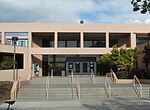Museum of Southwestern Biology
Museums in Albuquerque, New MexicoNatural history museums in New MexicoUniversity museums in New MexicoUniversity of New Mexico
The Museum of Southwestern Biology (MSB) is a research and teaching facility in the Department of Biology of the University of New Mexico (UNM). The museum's collections include vascular plants, invertebrates and vertebrates from the American West, Central and South America, and from throughout the world. It is open to visitors by appointment. The Museum was said in 1997 to hold the largest collection of frozen tissue samples (85,000) in the western hemisphere and has assisted in the study of emerging zoonotic pathogens such as the Hantavirus and the Lassa virus.
Excerpt from the Wikipedia article Museum of Southwestern Biology (License: CC BY-SA 3.0, Authors).Museum of Southwestern Biology
Vassar Drive Northeast, Albuquerque Nob Hill
Geographical coordinates (GPS) Address Nearby Places Show on map
Geographical coordinates (GPS)
| Latitude | Longitude |
|---|---|
| N 35.083 ° | E -106.621 ° |
Address
University of New Mexico (UNM)
Vassar Drive Northeast
87131 Albuquerque, Nob Hill
New Mexico, United States
Open on Google Maps








